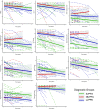The natural history of primary progressive aphasia: beyond aphasia
- PMID: 34216263
- PMCID: PMC8857134
- DOI: 10.1007/s00415-021-10689-1
The natural history of primary progressive aphasia: beyond aphasia
Abstract
Introduction: Primary progressive aphasia (PPA) is divided into three prototypical subtypes that are all characterized by their single core symptom of aphasia. Although later in their course, other cognitive, behavioral, and motor domains may become involved, little is known about the progression profile of each subtype relative to the other subtypes.
Methods: In this longitudinal retrospective cohort study, based on the recent biomarker-supported diagnostic criteria, 24 subjects diagnosed with semantic variant (svPPA), 22 with non-fluent variant (nfvPPA), and 18 with logopenic variant (lvPPA) were collected and followed up for 1-6 years. Symptom distribution, cognitive test and neuropsychiatric inventory scores, and progression into another syndrome were assessed.
Results: Over time, lvPPA progressed with broader language problems (PPA-extended) and nfvPPA progressed to mutism, whereas semantic impairment remained the major problem in svPPA. Apart from linguistic problems, svPPA developed pronounced behavioral disturbances, whereas lvPPA exhibited a greater cognitive decline. By contrast, in nfvPPA motor deficits were more common. Furthermore, within 5 years (IQR = 2.5) after clinical onset, 65.6% of the patients additionally fulfilled the clinical criteria for another neurodegenerative syndrome (PPA-plus). Fourteen out of 24 (58%) svPPA patients additionally met the diagnostic criteria of behavioral variant frontotemporal dementia (5.1 years, IQR = 1.1), whereas the clinical features of 15/18 (83%) lvPPA patients were consistent with Alzheimer disease dementia (4.5 years IQR = 3.4). Furthermore, 12/22 (54%) of the subjects with the nfvPPA progressed to meet the diagnostic criteria of corticobasal syndrome, progressive supranuclear palsy, or motor neuron disease (5.1 years IQR = 3.4).
Discussion: Despite aphasia being the initial and unique hallmark of the syndrome, our longitudinal results showed that PPA is not a language limited disorder and progression differs widely for each subtype, both with respect to the nature of symptoms and disease duration.
Keywords: Aphasia; Dementia; Frontotemporal dementia; Frontotemporal lobar degeneration; Mortality; Natural history; Primary progressive aphasia; Survival analysis.
© 2021. The Author(s).
Conflict of interest statement
The authors report no conflict of interests.
Figures



References
-
- Mesulam MM. Slowly progressive aphasia without generalized dementia. Ann Neurol. 1982;11:592–598. - PubMed
-
- Gorno-Tempini ML, Hillis AE, Weintraub S, Kertesz A, Mendez M, Cappa SF, Ogar JM, Rohrer JD, Black S, Boeve BF, Manes F, Dronkers NF, Vandenberghe R, Rascovsky K, Patterson K, Miller BL, Knopman DS, Hodges JR, Mesulam MM, Grossman M. Classification of primary progressive aphasia and its variants. Neurology. 2011;76:1006–1014. - PMC - PubMed
-
- Goldman JS, Farmer JM, Wood EM, Johnson JK, Boxer A, Neuhaus J, Lomen-Hoerth C, Wilhelmsen KC, Lee VM-Y, Grossman M, Miller BL. Comparison of family histories in FTLD subtypes and related tauopathies. Neurology. 2005;65:1817–1819. - PubMed
-
- Rohrer JD, Guerreiro R, Vandrovcova J, Uphill J, Reiman D, Beck J, Isaacs AM, Authier A, Ferrari R, Fox NC, Mackenzie IRA, Warren JD, de Silva R, Holton J, Revesz T, Hardy J, Mead S, Rossor MN. The heritability and genetics of frontotemporal lobar degeneration. Neurology. 2009;73:1451–1456. - PMC - PubMed
MeSH terms
LinkOut - more resources
Full Text Sources
Medical
Miscellaneous

